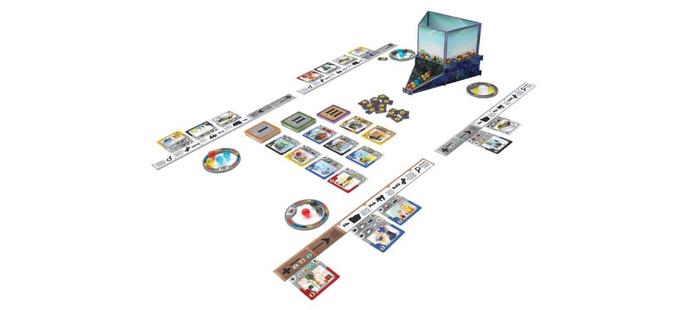Gizmos made my top ten games of 2018 and was the last game to sneak under the wire for the ranking—I have other 2018 releases that I didn’t get to in time for that list—after I got a full demo at PAX Unplugged and then started playing it regularly with my daughter. And I do mean regularly, because we both love the game and realized in just a few plays that we could slip in an entire two-player game in under a half an hour on a school night. It’s one of the fastest-playing engine building games I’ve come across, with the kind of rewards you want from a game like that but a lot less of the fuss.
From designer Phil Walker-Harding, who made my 2017 top ten with Bärenpark and landed a Spiel nomination in 2016 for Imhotep, Gizmos has players pretending to be students at a science fair, creating ‘projects’ that let them do more things on subsequent turns, thus creating the engines that will eventually allow players to buy better, more valuable cards. The game’s currency is marbles, coming in four colors, that are then used to build those project cards, which cost from one to seven marbles each, mostly requiring marbles of a single color. Once built, the cards give you bonuses for specific action types, and those bonuses can daisy-chain so that a single action can yield multiple benefits. That means turns early in the game are pretty quick, and get long only near the end of the game, when players might have a hard time remembering all of the goodies they get from certain actions.
The action types are all straightforward and dictated in part by the physical components. Gizmos comes with what I would best describe as a cardboard gumball machine that dispenses the energy marbles, with six marbles always on display in the chute in front, but with access to the entire pool available from the top. One action is to pick a marble from the six you see in front. Two actions allow you to take one of the nine cards from the display on the table, which come in three rows and increasing cost/power as you move up, and either build it immediately by paying its marble cost from your supply or file it to your archive so you can build it later. The fourth action is to research, where you take the top three cards from one of the three face-down decks, and may, if you wish, file or build one of them.

Each card you build gives you a specific benefit tied to certain actions—when you build a card, you’ll place it under one of the action spaces on your cardboard bar. For example, a card might tell you that any time you build a red card, you then get to pick one marble from the chute. Or it might say any time you select a blue marble from the chute, you may then pick one random marble (no peeking) from the top of the dispenser. So if you build a red card, then pick a blue marble from the chute, you can then take a random one from the top—everything connects except for random draws, which can’t trigger further actions.
There are other benefits from cards that pertain less to engine-building but still advance your abilities or just help you rack up points. You start the game with specific limits on what you can do: you can have no more than five marbles in your stash, can file only one card in your archive at a time, and can draw three cards when you research. Various cards you build will increase those limits, with the marble count the most important since level three cards can require seven marbles to build. There are also converter cards that let you swap one color marble for another, or that allow you to double the value of a specific marble. And some cards even award you extra victory points every time you take a certain action—gain one victory point every time you build a yellow card, for example.
The strategy in Gizmos is straightforward, then: build an engine and then use the fork out of it. Building in a little flexibility is good—you don’t want to build an engine that requires you to use lots of red marbles, only to find you’re not getting enough of them from the dispenser—but ultimately you want an engine that rewards you for two or maybe three things and then to keep doing those over and over. The game ends quickly, either when one player builds their 16th card or their fourth card from the top tier, so any turn when you’re not using one of your bonuses is a wasted opportunity.
Gizmos’ box says it’s for ages fourteen and up, but that’s probably because of the presence of the marbles, which are a choking hazard, not because of anything about the game, which I think any smart ten-year-old could handle as long as an adult helps explain the icons on the cards (there’s no text, all symbols). And the potential playing time of up to 50 minutes would require the full four players and at least one who can’t make up their mind on each turn—I think we all know who I’m talking about. It’s quick, light, a little deep, and most of all very satisfying. Even when I don’t win, I get something from the creation process. It’s the Little Engine That Could game, and if I happen to outscore you too, so much the better.
Keith Law is a senior baseball writer for ESPN.com and an analyst on ESPN’s Baseball Tonight. You can read his baseball content at search.espn.go.com/keith-law and his personal blog the dish, covering games, literature, and more, at meadowparty.com/blog.

